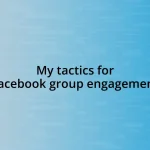Key takeaways:
- Emotional connections and genuine storytelling significantly enhance brand loyalty over traditional marketing tactics.
- Competitor analysis should focus on customer experiences and insights, not just product features.
- Effective branding is built on authenticity, understanding customer needs, and maintaining a consistent message across all platforms.
- Engagement strategies, including dialogue and relatability, are crucial in transforming casual consumers into loyal advocates.

Understanding Eclipse Brand Competition
Competing with Eclipse brands has taught me that understanding customer desires is key. I still remember my first experience at a trade show, listening intently to customers articulate what they value most. It struck me how deeply personal brand loyalty can be—it’s not just about the product; it’s about emotional connections and trust.
Eclipse brands thrive on differentiation, and I’ve seen firsthand how brands strategically position themselves to stand out in crowded markets. I often find myself reflecting on the strategies that have worked for me—like when I tested multiple marketing approaches and noticed how a single, relatable story can captivate an audience more than flashy advertisements. Isn’t it fascinating how something so simple can create such an impact?
In the competitive landscape, understanding the nuances of each brand’s strengths and weaknesses is essential. I once faced a situation where a competitor’s unique selling proposition led to a sudden surge in their sales. This taught me to always analyze not just my offerings but also what sets others apart. How do we truly understand what makes a brand successful? It goes beyond numbers; it’s about genuine insights into the brand’s journey and its connection with customers.

Key Insights from Competitor Analysis
When diving into competitor analysis, I discovered the importance of not solely focusing on products but really honing in on customer experiences. During one project, I closely monitored a leading brand’s social media engagement and found that their followers thrived on authentic narratives rather than polished marketing messages. This was a real eye-opener for me; it underscored how genuinely connecting with customers can drive loyalty more effectively than any promotional gimmick.
Here are some key insights that emerged from my analysis:
- Emotional Resonance: Brands that connect on an emotional level see higher customer loyalty. A heartfelt story can resonate more than a traditional advertisement.
- Unique Selling Proposition (USP): Understanding competitors’ USPs is crucial; it helps identify market gaps and strengths that can be leveraged in your own strategy.
- Customer Feedback Loop: Actively soliciting feedback and observing audience reactions can reveal nuanced insights about what truly matters to your target market.
- Community Engagement: Brands that foster community and encourage dialogue often cultivate a more robust and loyal customer base.
- Adaptability: The ability to pivot quickly based on competitor moves or market trends can set your brand apart, as I learned when reviewing successful brands that swiftly adjusted their offerings in response to emerging customer needs.
Through this process, I realized that competitor analysis is not just about crunching numbers; it’s about understanding the heartbeat of the market.

Strategies for Marketplace Differentiation
Crafting strategies for marketplace differentiation has been a game-changer for me. In my journey, I learned that a brand’s identity must resonate with its unique audience. Once, while analyzing a direct competitor, I noticed they were leveraging local art and culture in their branding. This connection not only distinguished them but also created a local fan base that felt personally invested in the brand’s success; it was a beautifully organic growth that struck a chord with me.
Another insight worth mentioning comes from my own branding efforts. I implemented customer-centric storytelling, sharing real-life experiences from users of my product. It astonished me how these relatable stories outperformed generic ads, driving engagement and building trust. I remember receiving heartfelt messages from customers who felt seen and understood; it just underscored how differentiation isn’t merely about standing out—it’s about standing up for something your audience cares about.
Lastly, I found that collaboration with influencers can be an effective differentiation strategy. For one of my campaigns, collaborating with a micro-influencer led to a community that felt like a close-knit family. Their genuine endorsement felt more authentic than traditional advertising could ever achieve. The result? Not only did we reach a new audience, but we also fostered deep connections. This reinforced my belief that relationships, not transactions, define a brand’s unique place in the marketplace.
| Strategy | Description |
|---|---|
| Emotional Resonance | Connecting with customers through storytelling to build loyalty and trust. |
| Community Engagement | Encouraging dialogue and participation to develop a dedicated audience. |
| Influencer Collaboration | Partnering with influencers to authentically reach new demographics. |

Effective Branding in Competitive Markets
Effective branding in competitive markets is all about forging real connections. I remember a time when I launched a product that had a similar demographic to a successful competitor. Instead of just showcasing features, I decided to share stories from our users—their struggles and triumphs. The feedback was illuminating. Customers resonated with these narratives, often expressing how they felt understood. It made me realize that authenticity can be a brand’s strongest voice amid the noise.
Understanding your audience is vital. While attending a marketing conference, I heard a speaker share her experience of revamping a failing brand. She emphasized the need to deeply understand her customers’ pain points before tweaking her messaging. What struck me most was how she utilized empathy in her campaign, transforming a lackluster brand into one that truly spoke to its audience’s needs. Isn’t it fascinating how a simple shift in perspective can lead to monumental changes in brand perception?
Another takeaway for me has been the power of consistency. I once encountered a brand that brilliantly tied their messaging to a cause—their commitment was evident on every platform. It was inspiring to see how their unwavering commitment resonated across various channels, gaining traction from diverse audiences. As I reflect on this, I wonder: how often do brands falter because they lack a cohesive message? In my own work, I strive for that consistency, as it decisively cements brand identity in a crowded marketplace.

Lessons in Consumer Engagement Techniques
Engaging with consumers requires more than just a clever marketing strategy; it necessitates authentic connections. I recall a campaign I launched where we actively invited our customers to share their thoughts on social media. The flood of responses was eye-opening; people appreciated being seen and heard. It dawned on me that fostering an environment for dialogue made them feel a part of the brand, transforming casual buyers into loyal advocates. Isn’t it powerful when customers feel like they have a voice in the brand narrative?
I also discovered the value of personal interactions at events. During one of our product showcases, I took the time to engage directly with attendees, listening to their stories and feedback. As we chatted, I noticed their eyes light up—it was as if they felt valued, and that sense of connection was palpable. Those moments taught me that real engagement often happens on a personal level, providing a deeper understanding of what consumers truly want. How often do brands overlook such simple interactions that can yield immense insights?
Finally, I found that humor and relatability can break down barriers, especially in a competitive space. I once ran a light-hearted ad campaign that poked fun at a common pain point in our industry. The responses were overwhelmingly positive—people appreciated the humor and felt a shared experience. This taught me that showing vulnerability and you can truly connect with your audience. Have you ever laughed with a brand? There’s something about humor that fosters camaraderie, making the brand feel more human and approachable.

Implementing Successful Brand Strategies
Implementing successful brand strategies requires a clear vision and an unwavering commitment to that vision. I once worked with a startup that initially struggled to define its unique value proposition. After numerous brainstorming sessions, we finally pinpointed what made us special. That clarity became our guiding light, influencing every campaign and communication strategy. Isn’t it amazing how a well-defined purpose can align efforts and resonate with consumers at a deeper level?
Another lesson I learned revolves around the importance of adaptability. During a seasonal promotion, I observed our competitors taking risks with innovative approaches. Inspired, I decided to pivot quickly, aligning our campaign with emerging market trends. The results were staggering; we captured attention at a time when others played it safe. This experience reinforced the idea that flexibility in brand strategies can open doors to unexpected opportunities. How often do brands stick to rigid plans, missing out on valuable chances to connect?
Engagement through storytelling also stands out to me as a powerful strategy. I vividly recall attending a brand event where the founder shared his journey—from struggles to triumphs—with an authenticity that captivated the audience. That genuine connection transformed the brand’s image in real-time. Since then, I make it a priority to weave personal narratives into our brand’s story, inviting customers to be a part of that journey. Isn’t storytelling an incredible way to build relationships that go beyond products?















